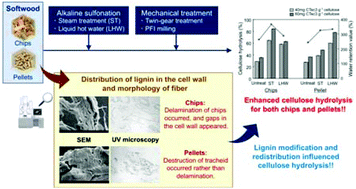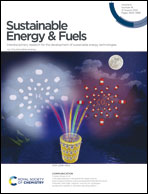The pretreatment of softwood chips and pellets by alkali sulfonation and thermomechanical pulping and its influence on lignin redistribution and the enzyme mediated hydrolysis of the cellulose component†
Abstract
Alkaline sulfonation followed by thermomechanical treatment of softwood chips and pellets successfully improved the enzyme-mediated hydrolysis of the cellulose component by the incorporation of acid groups onto the lignin component. Although steam treatment (ST) was more effective than liquid hot water (LHW) pretreatment of wood chips, in contrast, the LHW pretreatment of pellets was better. It was shown, via SEM and UV microscopy, that pretreated chips were delaminated at the middle lamella. Steam treatment produced gaps within the secondary wall, likely due to the rapid pressure release resulting in enhanced accessibility of the cellulose to the enzymes. In contrast, extensive destruction of the cell wall rather than delamination occurred in pellets pretreated by both ST and LHW. This was likely due to the lignins' more condensed structure. However, both pretreatments resulted in lignin redistribution and changes to the cell wall structure, which enhanced the enzyme-mediated hydrolysis of the cellulosic component.



 Please wait while we load your content...
Please wait while we load your content...